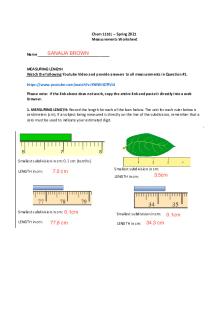Chemistry I lab Vsepr worksheet final PDF

| Title | Chemistry I lab Vsepr worksheet final |
|---|---|
| Author | Brindha Murali |
| Course | General Chemistry I |
| Institution | Rowan College of South Jersey |
| Pages | 8 |
| File Size | 565.1 KB |
| File Type | |
| Total Downloads | 26 |
| Total Views | 142 |
Summary
This is a lab worksheet for the general chemistry I lab . It explains and has questions about the VSEPR theory and diagrams....
Description
VSEPR and Molecular Modeling Lab Spring 2021 Hybrid
For this lab, there will be no formal lab report. You will follow the instructions below and complete the chart. You must turn this document in with all parts filled in according to the instructions. Objectives 1. To predict structure and polarity of a compound based on its Lewis Dot and VSEPR Theory Background Many molecules obey the octet rule and their Lewis-Dot structures are straightforward. Recall that to draw the Lewis-Dot structure of a molecule obeying the octet rule, eight electrons on each atom (except hydrogen and a few others) are arranged in four pairs. Each pair either participates in a covalent bond or is present as a lone pair. Some molecules have an odd number of valence electrons or may have an expanded octet. According to the Valence Shell Electron Pair Repulsion (VSEPR) Theory, the areas of high electron density move as far apart from each other as possible, without leaving the atom. It is the repulsion of lone pairs of electrons that causes the geometry or molecular structure of the molecule. The molecular shape is determined by the positions of the atoms in a molecule, which are influenced by bonds and lone pairs. The possible shapes for the molecules in this lab are linear, bent, trigonal pyramidal, tetrahedral, and trigonal planar. Shape Linear Trigonal planar Tetrahedral Trigonal bipyramidal Octahedral Bent (V shaped) Trigonal pyramidal Bent (V shaped) SeeSaw T Shaped Linear Square pyramidal Square planar
Electron Domains 2 3 4 5 6 3 4 4 5 5 5 6 6
Number of Lone Pairs 0 0 0 0 0 1 1 2 1 2 3 1 2
Bond Angle 180° 120° 109.5° 90° (ax) and 120° (eq) 90° 95°...
Similar Free PDFs

4.2 - Vsepr Theory - chemistry
- 5 Pages

Chemistry 1 Lab Final Review
- 20 Pages

Chemistry Worksheet
- 5 Pages

Vsepr Summary
- 1 Pages

Chemistry 161 General Chemistry I
- 10 Pages

Chemistry MSDS Worksheet
- 3 Pages

Chemistry 1 Worksheet
- 8 Pages

Lab 13 - Lab worksheet
- 6 Pages
Popular Institutions
- Tinajero National High School - Annex
- Politeknik Caltex Riau
- Yokohama City University
- SGT University
- University of Al-Qadisiyah
- Divine Word College of Vigan
- Techniek College Rotterdam
- Universidade de Santiago
- Universiti Teknologi MARA Cawangan Johor Kampus Pasir Gudang
- Poltekkes Kemenkes Yogyakarta
- Baguio City National High School
- Colegio san marcos
- preparatoria uno
- Centro de Bachillerato Tecnológico Industrial y de Servicios No. 107
- Dalian Maritime University
- Quang Trung Secondary School
- Colegio Tecnológico en Informática
- Corporación Regional de Educación Superior
- Grupo CEDVA
- Dar Al Uloom University
- Centro de Estudios Preuniversitarios de la Universidad Nacional de Ingeniería
- 上智大学
- Aakash International School, Nuna Majara
- San Felipe Neri Catholic School
- Kang Chiao International School - New Taipei City
- Misamis Occidental National High School
- Institución Educativa Escuela Normal Juan Ladrilleros
- Kolehiyo ng Pantukan
- Batanes State College
- Instituto Continental
- Sekolah Menengah Kejuruan Kesehatan Kaltara (Tarakan)
- Colegio de La Inmaculada Concepcion - Cebu







